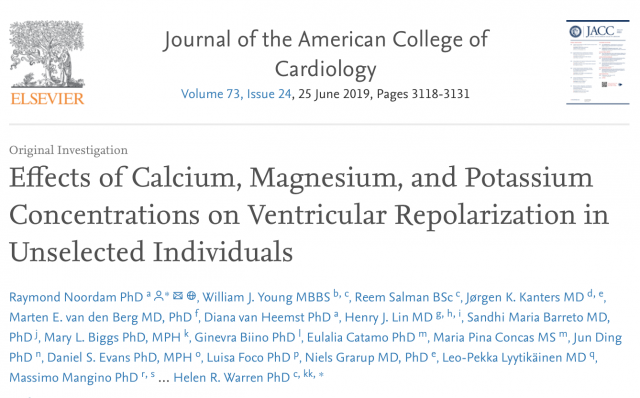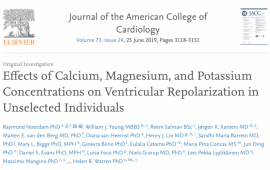Abstract
BACKGROUND:
Subclinical changes on the electrocardiogram are risk factors for cardiovascular mortality. Recognition and knowledge of electrolyte associations in cardiac electrophysiology are based on only in vitro models and observations in patients with severe medical conditions.
OBJECTIVES:
This study sought to investigate associations between serum electrolyte concentrations and changes in cardiac electrophysiology in the general population.
METHODS:
Summary results collected from 153,014 individuals (54.4% women; mean age 55.1 ± 12.1 years) from 33 studies (of 5 ancestries) were meta-analyzed. Linear regression analyses examining associations between electrolyte concentrations (mmol/l of calcium, potassium, sodium, and magnesium), and electrocardiographic intervals (RR, QT, QRS, JT, and PR intervals) were performed. The study adjusted for potential confounders and also stratified by ancestry, sex, and use of antihypertensive drugs.
RESULTS:
Lower calcium was associated with longer QT intervals (-11.5 ms; 99.75% confidence interval [CI]: -13.7 to -9.3) and JT duration, with sex-specific effects. In contrast, higher magnesium was associated with longer QT intervals (7.2 ms; 99.75% CI: 1.3 to 13.1) and JT. Lower potassium was associated with longer QT intervals (-2.8 ms; 99.75% CI: -3.5 to -2.0), JT, QRS, and PR durations, but all potassium associations were driven by use of antihypertensive drugs. No physiologically relevant associations were observed for sodium or RR intervals.
CONCLUSIONS:
The study identified physiologically relevant associations between electrolytes and electrocardiographic intervals in a large-scale analysis combining cohorts from different settings. The results provide insights for further cardiac electrophysiology research and could potentially influence clinical practice, especially the association between calcium and QT duration, by which calcium levels at the bottom 2% of the population distribution led to clinically relevant QT prolongation by >5 ms.
Last updated on: 05/06/2021 - 11:40



